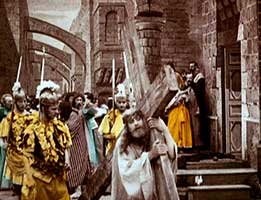 I figured that anyone who could make a film about taking a dump in a phone booth, the theme of Ferdiand Zecca's The Wrong Door (Erreur de porte, 1905), well, a guy that crazy could perhaps make even the life of Jesus Christ pretty amusing for even areligious viewing.
I figured that anyone who could make a film about taking a dump in a phone booth, the theme of Ferdiand Zecca's The Wrong Door (Erreur de porte, 1905), well, a guy that crazy could perhaps make even the life of Jesus Christ pretty amusing for even areligious viewing.
The Life & Passion of Jesus Christ (La Vie et la passion de Jesus Christ, 1902, expanded 1905) is the longest film ever made up to 1905 (approaching three quarters of an hour), so it's an important piece of silent film history, just one more reason to see it. And for the trick photography alone, it ought to be worth something.
Alas, I figured wrong, & the disc I viewed with two early silent film biographies of Jesus, including Zecca's, are mainly for Christians who would like to see some fairly basic New Testament illustrations moving about. For a silent film fan per se, it's the equivalent of being enamored of vintage books but finding only an old copy of the Gideons' bible.
The film certainly can be praised for being gorgeously pictorial. It takes the main cues for its tableaus from classical paintings. The last supper brings Leonardo de Vinci's painting to life. Actors' main mission is not to convey the story of Jesus as an interesting story in & of itself, but to move themselves into the correct position for the tableau, becoming religioius icons.
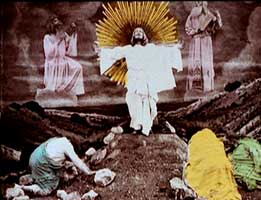 The artfully designed sets are sometimes awesome. I especially liked the look of the street in Bethlehem, the beautifully constructed street blending into the backdrop painting almost seamlessly. The artfully designed sets are sometimes awesome. I especially liked the look of the street in Bethlehem, the beautifully constructed street blending into the backdrop painting almost seamlessly.
Throughout, select scenes are hand-tinted by Pathe's patented stencil process. Almost any scene taken as a still would look right at home as an illustration plate in the New Testament.
The way in which the film avoids interpretation or even characterization renders the whole point one of pious experience for believers. But there was one "interpretive" bit that surprised me. The four-winged angel of the annunciation, vis, the Archangel Michael, is distinctly female. There are many cultic reasons for this but it's a minority belief that this angel was actually the Divine Sophia, equivalent of the Shekhinah of Jewish mysticism, female presence of god.
Possibly Zecca as a French director was influenced by the lingering gnostic influences in Southern France where formerly the Holy Ghost was acknowledged as the Mother of the Trinity. Of course, this lingering influence is still seen in even some fairly ordinary Catholic art, wherein women serve time & again as the artists' models for angels.
For its value as cinematic history I'm glad to have seen it, but this was not easy viewing. It was like standing at the front door pigeonholed by a Jehovah's Witness for over half an hour.
But in its day it broke a barrier for the film-going public, as films of the era drew on burlesque & vaudeville, providing veritable peepshows. Women would not be regarded as a significant part of the audience, & children's presence would be inappropriate. Zecca's Passion was the first step in transforming movies into family events.
It has prettiness & some cute special FX, but other than the presence of the amazonian archangel, there's nothing novel about this collection of familiar biblical illustrations void of emotion or character.
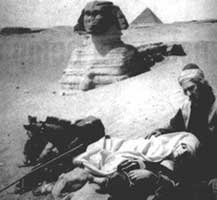 On the same dvd disc was From Manger to The Cross; or, Jesus of Nazareth (1912). It's a Sunday School history lesson filmed on authentic locations of the Holy Land including Jerusalem & Bethlehem. On the same dvd disc was From Manger to The Cross; or, Jesus of Nazareth (1912). It's a Sunday School history lesson filmed on authentic locations of the Holy Land including Jerusalem & Bethlehem.
As such Sidney Olcott's film lacks the aesthetic pictoriality of Zecca & Nonguet's version, but it looks much more real.
So too the acting is getting closer to naturalistic, thus it is more emotional, including such scriptural moments as Jesus's fear, weeping, & doubt in the Garden while his disciples abandon him in their sleep.
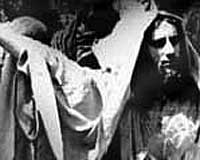 The crucifixion too is more real rather than a pretty post card, though the Olcott take on being nailed to the cross certainly would make a pleasant enough scary post card. The crucifixion too is more real rather than a pretty post card, though the Olcott take on being nailed to the cross certainly would make a pleasant enough scary post card.
The 1912 film also uses a lot of text cards to spew scripture giving it a preachier purpose, while the 1902/5 take assumes all good Christians know the story perfectly well & don't need to be informed what that part of their bible has to say on the matter.
Curiously this version skips the Resurrection, which I would've thought the most important part for the primary audience who expects Jesus to be a supernatural deity rather than a strictly historic martyred rabbi.
And while Zecca's film drums up a tiny bit of thrills for fans of early trick photography -- & is very amusing when Jesus rises from the tomb as if on an elevator -- Sidney Olcott's Vitagraph film strives more toward making Jesus's life seem historic rather than only a pretty myth. So there's a lot less trick photography; the angel of the annunciation is invisible rather than a four-winged feminine archangel; & there's no elevator to heaven.
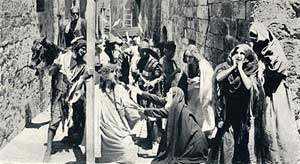 When FX are attempted, as when Jesus walks on water, it's kind of silly looking rather than like a painting sprung to life, although to be sure both films take most of their visual cues from familiar artworks, Zecca from classical paintings & stained glass, Olcott from pious & mass-produced Victorian art art & engravings, especially the watercolors of James Jacques-Joseph Tisso. When FX are attempted, as when Jesus walks on water, it's kind of silly looking rather than like a painting sprung to life, although to be sure both films take most of their visual cues from familiar artworks, Zecca from classical paintings & stained glass, Olcott from pious & mass-produced Victorian art art & engravings, especially the watercolors of James Jacques-Joseph Tisso.
So while Zecca's film resembles medieval sacred art, Olcott's resembles either pop art on sacred subjects or (thanks to on-location shoots) fuzzy photographic illustrations in cheaply made old tourist books about the Holy Land.
I can like a religious story a lot if it actually tells a story; & the story of Jesus could, it seems, be as exciting as the story King Arthur or any popular historic fantasy. But these two short films in attempting to cover everything from before birth to after death end up being little more than a collection of post cards or bookmarks passed around in churches.
copyright © by Paghat the Ratgirl
|
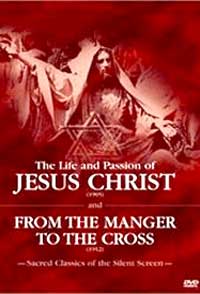

 The artfully designed sets are sometimes awesome. I especially liked the look of the street in Bethlehem, the beautifully constructed street blending into the backdrop painting almost seamlessly.
The artfully designed sets are sometimes awesome. I especially liked the look of the street in Bethlehem, the beautifully constructed street blending into the backdrop painting almost seamlessly.
 The crucifixion too is more real rather than a pretty post card, though the Olcott take on being nailed to the cross certainly would make a pleasant enough scary post card.
The crucifixion too is more real rather than a pretty post card, though the Olcott take on being nailed to the cross certainly would make a pleasant enough scary post card. When FX are attempted, as when Jesus walks on water, it's kind of silly looking rather than like a painting sprung to life, although to be sure both films take most of their visual cues from familiar artworks, Zecca from classical paintings & stained glass, Olcott from pious & mass-produced Victorian art art & engravings, especially the watercolors of James Jacques-Joseph Tisso.
When FX are attempted, as when Jesus walks on water, it's kind of silly looking rather than like a painting sprung to life, although to be sure both films take most of their visual cues from familiar artworks, Zecca from classical paintings & stained glass, Olcott from pious & mass-produced Victorian art art & engravings, especially the watercolors of James Jacques-Joseph Tisso.